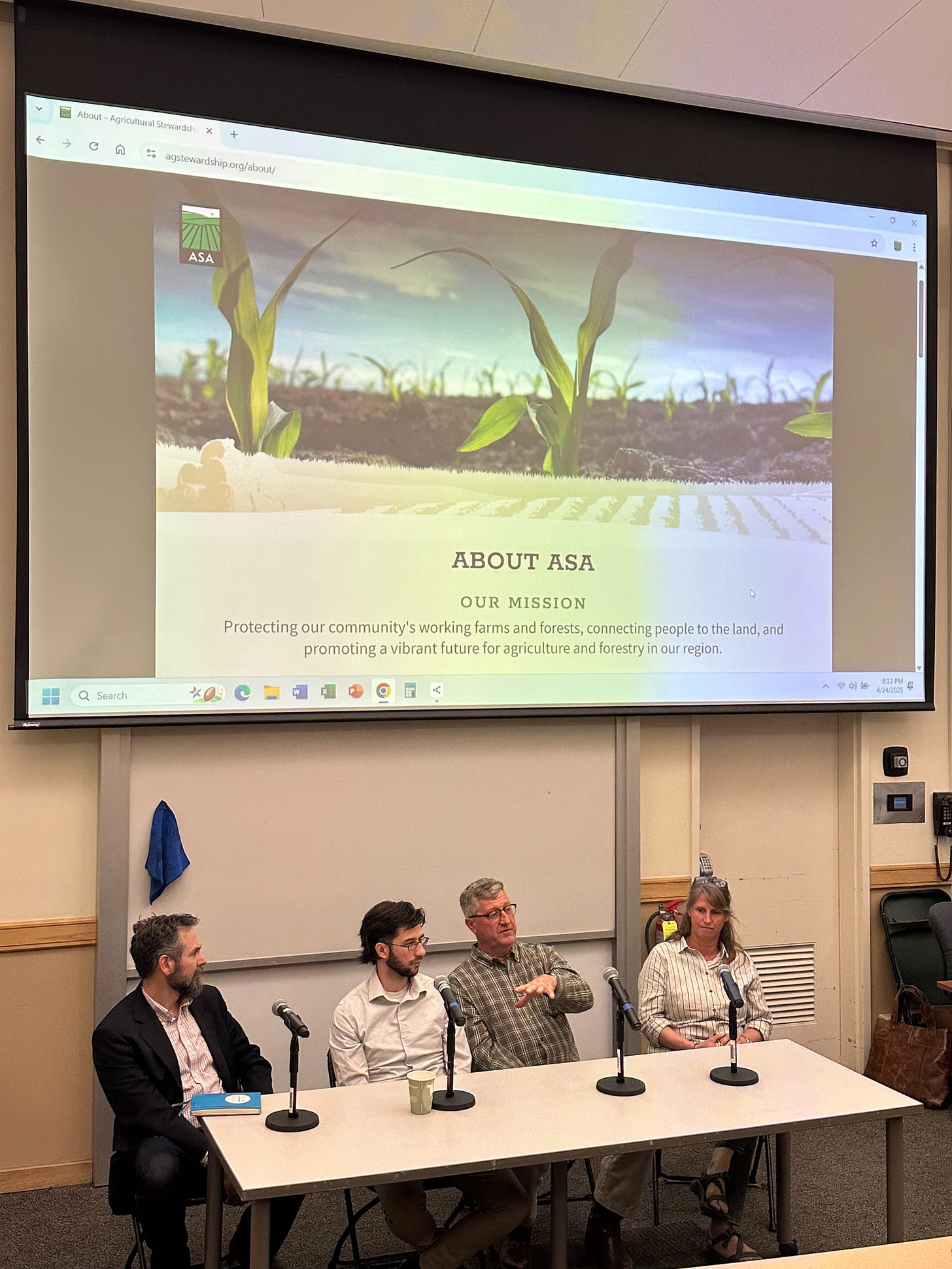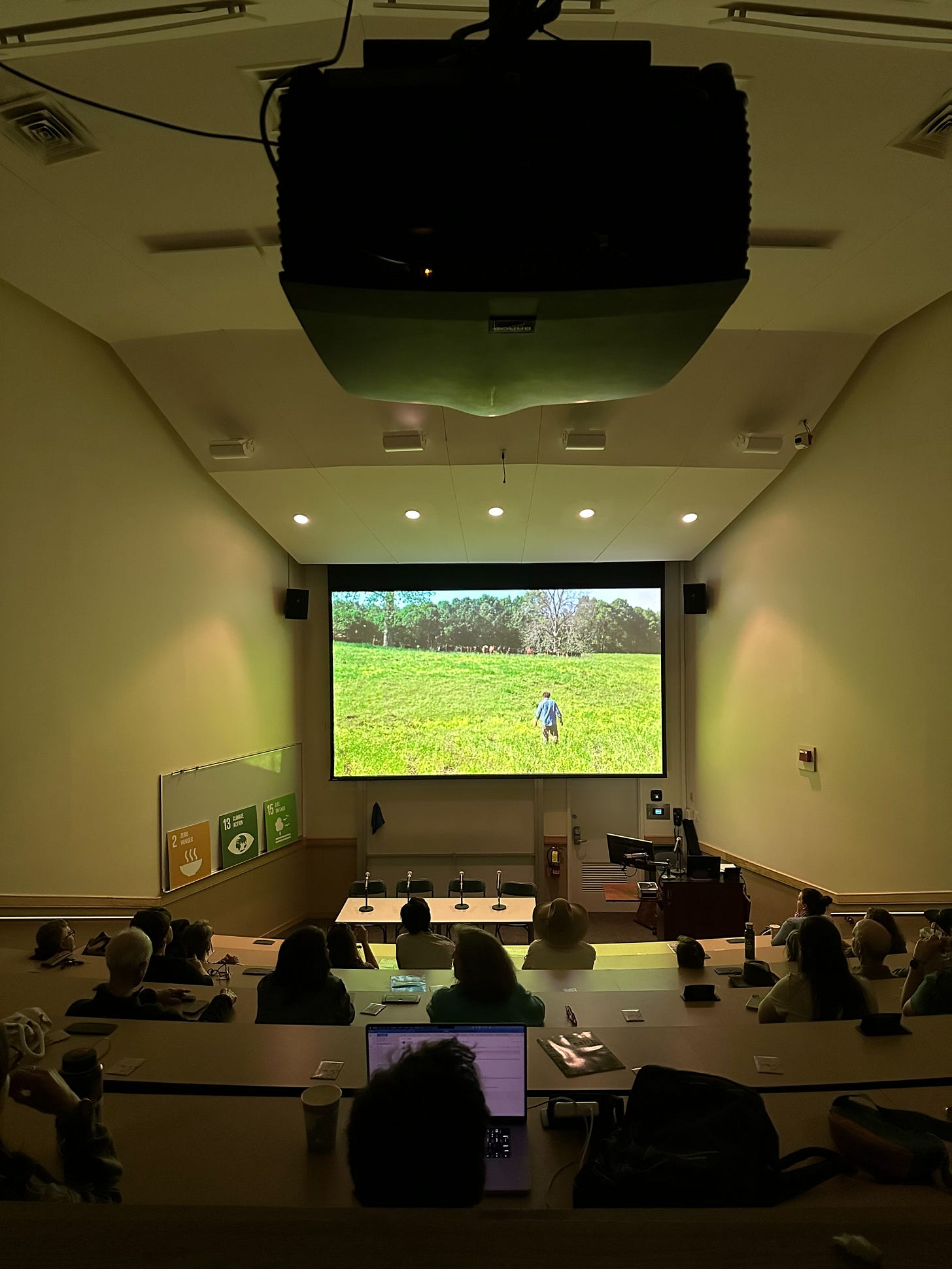This week was packed to the brim with farm life stuff—but I’ll save those things to share with you next week because I wanted to share with you my highlight of the week!
Prior to moving to the Little Dream Farm, I’d spent the better part of two years deep down a rabbit hole learning about regenerative agriculture, conventional farming, the medical system, and our food systems.
This was through the lens of wanting to improve our own health by eating better quality food, supporting local farmers outside the Philadelphia area, and turning around and teaching everything I was learning and implementing to my personal training and nutrition clients.
It became a personal fascination…an obsession really, and I’ve loved every minute of this hobby of learning about food and farming and the connection to our health and wellbeing.
It also added to our little dream and desire of wanting to own and live on our very own farm. And when the LDF came into our view, we couldn’t believe we’d found an organic, sustainable farm that wasn’t sprayed with chemicals and tilled to oblivion and planted in a monocrop like corn.
Sure, we didn’t know yet know what we were going to do with a farm, but the LDF checked a big box for me and aligned completely with my newly minted values regarding farming and agriculture. It allowed us to become stewards of something I’ve come to believe in very deeply and to continue to care for this farm in that manner—working with nature instead of against her.
Regenerative agriculture is a holistic farming approach that aims to improve soil health, biodiversity, water cycles, and climate resilience, while also enhancing the productivity and profitability of farms.
While “regenerative” has become a buzzword coopted by many industries beyond farming (medical, beauty, wellness), the longer you study regenerative agriculture, the more you begin to understand that it’s not new…in fact, it’s what animals and nature and farmers were doing before conventional agriculture became the widespread way of farming.
Conversely, the more you study conventional farming, the more you scratch your head and ask why we ever adopted this method of farming that is wholly unconventional to nature. You’re smart so I know you’re already thinking…profits. But certainly not profits for farmers. It’s profits for the chemical fertilizer companies, the largest food and beverage companies in the US (and around the globe), the farming equipment companies…and the list goes on.
So one evening this week I attended an event put on by the Agricultural Stewardship Association and Skidmore College in Saratoga Springs, NY.
It was a screening of two parts of the four-part film Roots So Deep followed by a panel discussion with two local farmers, a professor and business owner in the soil data space, and the executive chef of an incredible restaurant in Saratoga Springs who uses the meat from one of the farmers on the panel in his menu at the restaurant.
Roots So Deep is a documentary series featuring innovative farmers and self-acclaimed maverick scientists working to build a path to solving climate change with hooves (of cattle), heart, and soil health.
It's a really inspiring, positive, data-driven, human, and good-humored film about a concept called Adaptive Multi Paddock grazing—a facet of regenerative agriculture— and its beneficial impacts.
The film dives into this regenerative model that supports soil health and with it the vitality of ecosystems. It comparatively studies conventional and regenerative grazing systems using science and experimentation.
The team of scientists work together to ask and answer if this way of grazing cattle, that mimics the natural way bison once roamed the prairies, can restore our depleted soils, rebuild wildlife habitat and draw down huge amounts of carbon from the atmosphere back into the earth.
Our farmer, John, and his wife Eva, whom we source our meat from, attended the event, as John was one of the farmer panel members.

I’ll never forget the day I drove up to see the farm for the very first time. I passed by their house and farm on the way to the LDF, saw their farm sign and the Grassfed Beef distinction on the sign, and thought to myself, Well, that’s where we’ll get our meat if we move here! Not even knowing that John is one of a small handful of regenerative farmers in this area.
Since then, I’ve had the honor and privilege of having many discussions with John and Eva about farming and their farming practices. John has also taken me out into the pastures to show me how he raises their meat chickens and how he rotates his paddocks of cattle. He’s partnered with another incredible young farmer, Mark, who raises their pork and lamb. Together, they make a phenomenal team, and this community is so lucky to have them both working so hard to feed so many of us.
It’s meant the world to me to be directly connected to our farmers in this way. That I get to sit in the kitchen of their home on the farm that has been in their family since 1932, and that I can hug and say I love you to the very people who work so hard to raise our food and nourish our bodies.
I asked Eva one time when I first met her… “Do you ever just sit back around dinner time and think about how many people are being fed and nourished by your hard work? How many family meals are being had? How many moments shared and memories made over the work you two have spent the better part of your life doing?”
We’ve purchased just about every single cut and type of meat they offer—everything from whole chickens to beef liver and beef tongue. I told Eva when we first moved here that my goal was to learn how to cook every cut and type of meat I could get my hands on, and that we wanted to experiment and try new things as often as possible.
My appreciation for John and Eva has only grown as I learned of the news of my Hashimoto’s diagnosis in 2023 and now my bulging discs issue with my spine this year. I’ve leaned in even further and turned to them to help restore my health and nourish my body. Food is the medicine. I’ve relied far more on my farmers than I have my doctors to heal.
Earlier this week I saw an endocrinologist for my thyroid and she said, “Well whatever you’re doing is really working so keep after that!”
All that nourishing bone broth I’ve been making from the whole chickens we get from John and Eva are working wonders for my gut health, healing and restoring the discs in my spine, and doing wonders for my skin, hair, and nails.
I’m sharing this all with you because I think you’d absolutely love the film Roots So Deep. You can rent or buy the four-part film via their website for just $10, and I can’t recommend it enough. You’ll learn so much and you’ll laugh a lot, and you don’t need to know a thing about farming or agriculture to watch it.
Surely, when I started down this path, I didn’t know a thing! I was born and raised in suburbia, lived around Air Force bases and in cities all my adult life, and never had any direct connection to farming. For me, it began with the question, “What’s in this?” when looking at certain foods and seeking to improve my health. It’s quite possibly been the most important question I’ve ever asked in my life, as it eventually has led to me being able to write a Farm Note like this, and so much more.
Please do let me know if you plan to watch the film, as I’d love to hear about what you think once you do! The title of this Farm Note will make far more sense once you watch it.
You can check it out and rent it by visiting their website here.
In case you’re interested, here’s the panel and their sites and info if you’d like to check them out, too.
John Moore, Farmer & Owner of St. Croix Farm in Schaghticoke, NY
Elizabeth Collins, Farmer & Owner of Otter Creek Farm in Pittstown, NY
Alex Lempka, Executive chef of Hamlet & Ghost in Saratoga Springs, NY
Kristofer Covey, Assistant professor of Environmental Studies & Sciences at Skidmore College, NY and Co-founder & President of the Soil Inventory Project
Did you enjoy this Farm Note? Please do let me know by tapping the heart or by leaving a comment and sharing your thoughts.
I’d love mix in more content like this in order to share in all the things I’ve learned along the way and also give you some greater context to how we steward and manage the Little Dream Farm. Maybe it might help you find local farmers where you live and you can share in the joy of being more directly connected to your food. For me personally, it’s been one of the greatest gifts of my life and has added so much meaning and connection and appreciation of nature and animals and farmers to my life. I wish the very same for you.







As the granddaughter of a 2nd generation citrus farmer, I GET the spraying of chemicals, the fertilizing, the irrigation and all the other things that go into it. The vast majority of our families citrus went to the Hood's Processing Plant to be turned into juice. My grandfather would sell the fruit to them for pennies on the dollar, then he would buy back the peels that the Hood's people dried as treat/feed for his hobby White Faced Hereford cattle for way more than pennies on the dollar! You don't go into farming to get rich, that's for dadgummed sure! I'm glad to see the thoughts are changing with some of the farmers. I don't know as we will ever NOT have singular producing farmers because of the high demand for wheat, corn, potatoes and the like. Our family legacy died when my grandfather passed away. The land was more than the citrus that grew on it. That was the late 1970s when the second big "move to Florida" boom took place. Of the original 168 acres of land that my Great, great, great grandparents homesteaded in the 1860s, there is only a little over an acre left that is still owned by my family. My sister, her husband and their kids live in the house that we all grew up in. Everything else has homes and strip malls on it. Grandpa useta say, "They call it progress, bit I don't know where they're progressin' to." Wise words from a wise man.
❤️